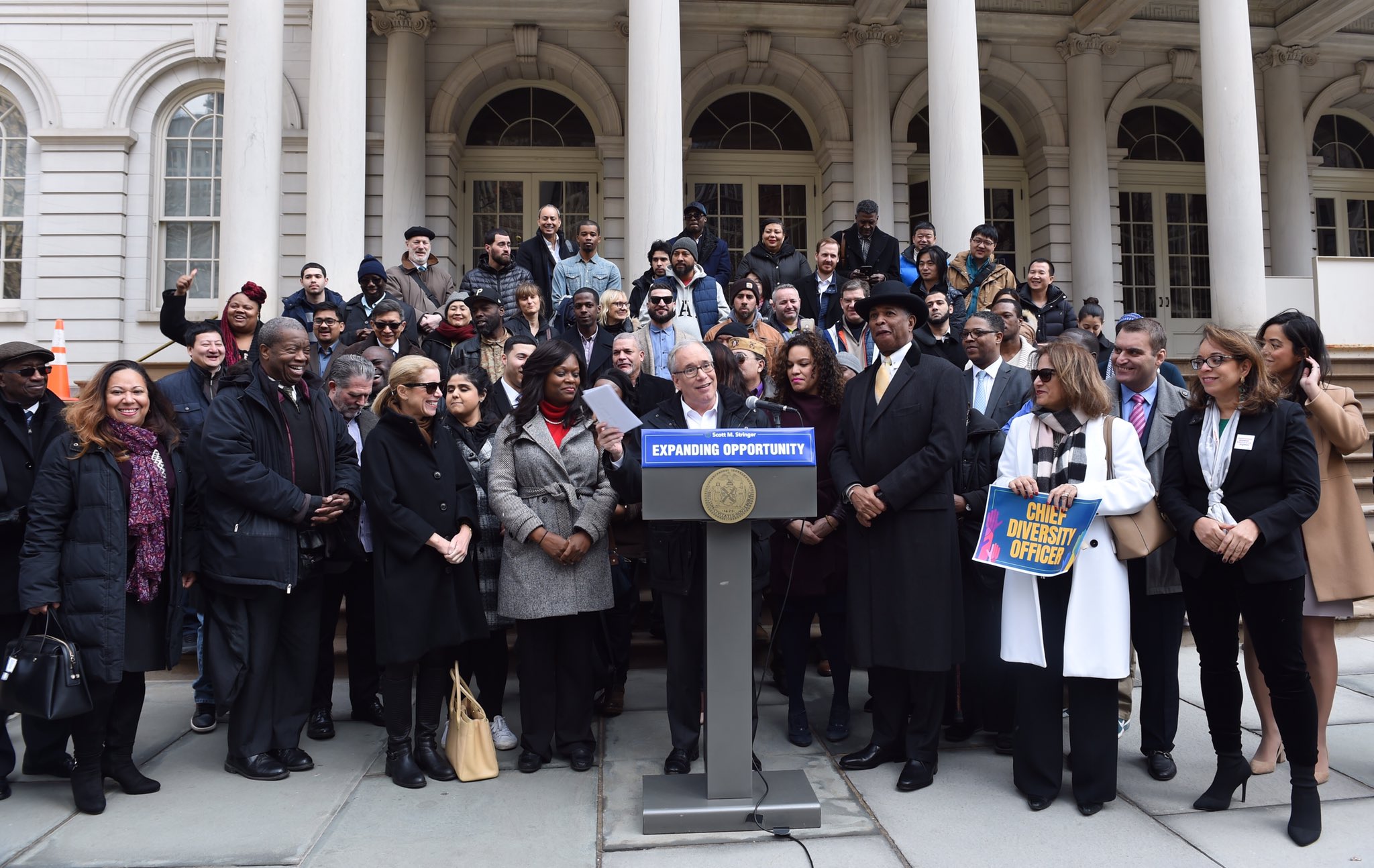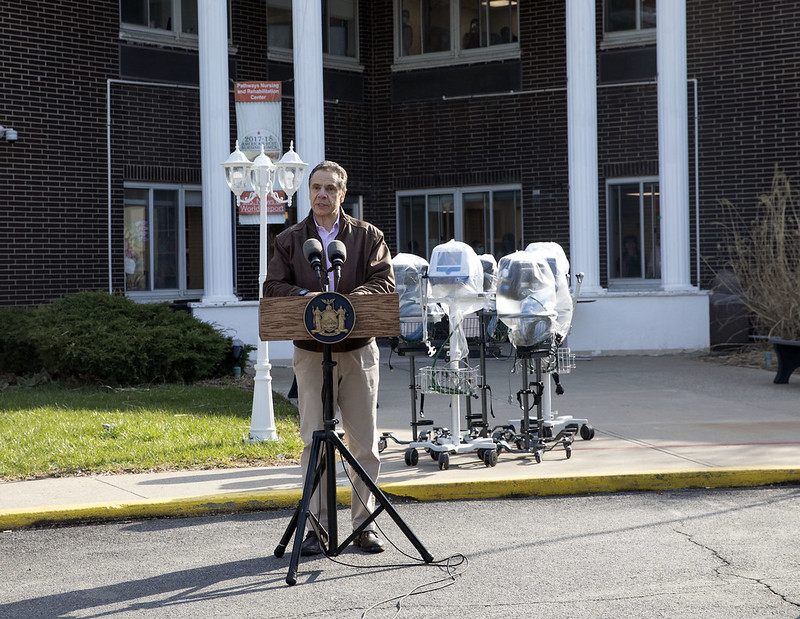New York City Needs a Chief Diversity Officer Now

Comptroller Scott Stringer, the author, calling for a CDO (photo: Comptroller's Office)
The murders of George Floyd, Breonna Taylor, and Ahmaud Arbery catalyzed one of the largest social justice movements in United States history, rightfully forcing both the public and private sectors to finally listen to Black lives who have sounded the alarm for decades. Under heightened scrutiny, many corporations have taken preliminary steps to acknowledge and confront the systemic racism ingrained within their organizations – cognizant that to ignore the deafening cries for justice is a tacit admission of complicity that can have major consequences for bottom lines.
Whatever their motives, major players like Wells Fargo, Morgan Stanley, Korn Ferry, and Zoom have made the decision to hire Chief Diversity Officers (CDOs) who can serve as bridges between stated good intentions and reality. When utilized effectively, CDOs identify both overt and covert racism across the spectrum of workplace policy – hiring, retention, culture, management, and more – and implement strategies to course-correct.
It’s time for the public sector to do the same. I created a CDO position within the office of the New York City Comptroller when I took office in 2014, and the role has become an essential function of our office. Our CDO serves as an invaluable resource to New York City’s minority- and women-owned business enterprises (M/WBEs) navigating the labyrinth of city contracting and, most recently, the ongoing economic fallout of the COVID-19 pandemic.
With a CDO in place, we’ve increased diversity among the firms managing more than $205 billion in city pension assets, and we’ve launched successful initiatives to increase transparency and accountability in corporate America’s hiring practices. In recent weeks, our CDO has guided important officewide conversations as we work toward inclusivity, equity, and representation in all areas of our work. As a white, cis-gender male elected official, it’s my responsibility to create space, listen, and make sure that we’re walking the walk – and to commit to doing better when we fall short. We could not do this without our CDO keeping us on track.
Seeing firsthand the impact this position can create in a public office, I’ve urged New York City to embrace the role of a CDO to address the systemic racism that we know exists in all government institutions at every level. Last year, I joined a broad coalition of civic and faith leaders and owners of M/WBEs calling on the City Charter Revision Commission to install a CDO in City Hall, reporting directly to the Mayor, and one within every city agency.
A CDO for New York City would function as city government’s executive level diversity and inclusion strategist, driving the representation of people of color and women across government, tracking and overseeing the city’s M/WBE programs, and determining whether agencies’ daily practices are equitable. A citywide CDO could begin to tackle long-standing disparities that are now coming into stark relief -- from analyzing how taxpayer dollars are spent through an intersectional lens to removing barriers to doing business with the city to making sure public service is a viable option for people from diverse backgrounds and experiences.
That charter revision proposal did not make it onto the ballot – but the need for CDOs in government is now more apparent than ever and it’s not too late to act.
New York City agencies spend almost $20 billion a year on everything from pens and paper to consulting services and construction, yet less than 5 percent of those contracts are awarded to M/WBEs. In my most recent Making the Grade report, which grades city agencies on their spending with M/WBEs, the city earned a “C” grade with Hispanic-American-owned businesses, a “D” grade with women-owned businesses, and a dismal “F” grade with African-American-owned businesses.
Eighty percent of New Yorkers are either women or people of color and more than 600 languages are spoken on our streets; we cannot settle for an exclusionary status quo. A CDO could help break down the biases baked into our contracting processes, and make sure our spending represents the diversity of our city, its economy and its people.
We don’t need to wait for another Charter Revision Commission – the mayor can take administrative action right now to create Chief Diversity Officer roles within City Hall and across agencies. While the private sector has recognized the value empowered CDOs bring to institutions, local government continues to be years late and many billions of dollars short. We should not fall further behind. As we work toward a more just New York City, we need Chief Diversity Officers to help lead the way.
***
Scott Stringer is New York City Comptroller. On Twitter @NYCComptroller.
***
Have an op-ed idea or submission for Gotham Gazette? Email This email address is being protected from spambots. You need JavaScript enabled to view it.
Governor Cuomo: Stop Scapegoating Nursing Home Workers and Making Excuses for Your Deadly Decisions

Governor Cuomo outside a nursing home (photo: Mike Groll/Governor's Office)
After Governor Cuomo forced nursing homes to admit COVID-positive patients, more than 6,300 aging New Yorkers died in those homes throughout the state. The state’s order required nursing home workers to care for patients in dangerous, inhumane, and sometimes deadly conditions, without adequate protections, including personal protective equipment.
Yet this week the governor again blamed nursing home workers for the state’s nursing home deaths — pointing the finger at staff who were working in life-threatening conditions. Instead of scapegoating staff, the governor should take responsibility for his deadly nursing home mandate, and start putting New York’s elderly population and care workers first.
On March 28, as coronavirus cases were spiking across the state, Governor Cuomo’s health department issued a mandate requiring nursing homes to accept patients with the novel coronavirus. The results were inevitably deadly: well over six thousand deaths from the virus. And this wasn’t the first time the governor put elderly New Yorkers and their families in harm’s way during the pandemic.
During this year’s budget negotiations, Governor Cuomo also slipped language into a bill providing immunity to nursing home executives. The Greater New York Hospital Association, which donated $2.3 million to Cuomo’s re-election campaign, literally wrote the budget language.
Cuomo has served as governor for more than nine years. During that time, he has allowed the nursing home industry to flout regulations. This failure during his long tenure turned nursing homes into unregulated pandemic graveyards waiting to happen. Yet when asked who holds blame for nursing home deaths, the governor pointed the finger at overworked and unprotected nursing home workers.
The majority of nursing home staff are people of color. During COVID-19, they’ve often not been provided with PPE. Poverty wages regularly force nursing home workers to work in more than one nursing home, without the ability to take sick leave. Blaming nursing home workers for the spread of the coronavirus, instead of blaming the state’s dangerous policies, threadbare regulations, and inadequate PPE, is cruel and irresponsible.
New York also has the highest racial disparity of COVID-19 cases in nursing homes of any state in the country. Eighty-four percent of New York nursing homes where at least a quarter of the residents were Black or Latino had COVID-19 cases. By comparison, just 33% of homes where the population was less than 5% Black and Latino had COVID-19 cases. Simply put, residents of color have been far more likely to live in a nursing home with COVID-19.
It’s clear the state has failed to prioritize nursing home workers and New York’s seniors — and particularly workers and seniors of color. Rather than continue to deflect blame, the governor should invest deeply in universal, dignified long-term care for all New Yorkers. The state needs to invest more funding into home-care services for better conditions for workers and to allow elders to remain home where possible with supporting family caregivers.
New York’s aging adults and people of color are not disposable. And nine-and-a-half years into his tenure, Governor Cuomo knows what he’s doing. When the governor lets thousands of nursing home workers and residents die, then blames them for their own deaths instead of taking responsibility, he knows he’s deflecting blame. It’s time for the governor to accept responsibility — both for his deadly nursing home mandate, and for the well-being of New York’s vulnerable seniors and nursing home workers.
***
Bobbie Sackman is a steering committee member of the New York Caring Majority, a statewide coalition of New York seniors, people with disabilities, and care workers.
***
Have an op-ed idea or submission for Gotham Gazette? Email This email address is being protected from spambots. You need JavaScript enabled to view it.
Getting New York City's Events Industry Up and Running Again

When can event spaces come back in New York City? (photo: VERSA)
The future is coming into focus. New York City is starting to reopen, and officials are releasing specific guidelines on how different industries can get back up and running, such as regulations for outdoor dining. Empty middle seats and temperature checks are clearly in the future for airlines.
But what about the events industry, which brings in $10 billion and employs approximately 500,000 in the State of New York? As CEO of the Backal Hospitality Group, I’ve seen first-hand how the events industry in New York City has been utterly flattened by the coronavirus. While restaurants have been able to pivot to offer takeout, curbside pickup, or delivery when New York first went on “pause,” and airlines are still able to fly throughout the past few months, the events industry has come to a complete halt, the hardest hit among businesses based on the idea of bringing groups of people together.
With all the daily announcements from Albany, it is still unclear which of the four reopening phases will allow events to restart.
Backal Hospitality Group employs up to 200 individuals and creates corporate events, fundraising galas for not-for-profits, and social gatherings. We cannot fall between the cracks (or phases). The many thousands who count on the events industry for their incomes are eager to get back to work and want to do so safely. How do we rebuild?
Following the recommended guidelines for health and safety protocols from officials, those of us in the industry need to be proactive, creative, and aggressive in coming up with solutions ourselves; ideas that will preserve the appeal of what we offer while making customers feel safe because they are safe. It might seem like an impossible task, but it’s not.
First, we will have to accept that our events may look different in the beginning. We must adapt, even if it brings some temporary financial pain. For a time, our profit margins will be stretched if not eliminated, but at least we will be doing any business at all. We must recognize we are in this for the long run, and we will have to rebuild step by step slowly and steadily to get where we need to go and preserve our industry that employs everyone from independent florists to caterers to local entertainment to photographers and many more.
If we smartly implement health and safety protocols for all events, which go hand-in-hand with the goals of elected officials, then we may avoid having our industry on hold for months longer, which would be devastating to the livelihood of thousands of New Yorkers.
Here are some ideas:
Governor Cuomo has allowed groups of 25 to gather. It’s more than the original groups of 10 he authorized, but, since this still isn’t much of an event in terms of our industry, why not several groups of 25 in smaller, separated rooms? Would that be the basis for a socially-distanced evening or lunch?
In New Jersey and Connecticut, both governors are allowing larger groups, including Gov. Ned Lamont of Connecticut who may permit groups up to 250 by mid-July with social distancing protocols still in place. As Governor Cuomo has said before, I think the region should be unified on such regulations.
Could guests be brought into an event on a staggered and reserved timeline, cycling through and with thorough cleanings in between each group, so that the overall group never gets too large?
What is safer – sit-down dining or pass-around appetizers? And why not use one of the more elegant and simple dining systems ever conceived: the Bento box? These could contain multiple items for a single guest, and no passing them around. And they can be made quite beautifully.
All servers will of course wear masks and gloves. A few months ago, this might have seemed strange, even alarming, but this is our new normal for the health and safety of all of us.
Then there is the great outdoors. Let’s take a cue from the restaurant industry.
Perhaps, before the pandemic, you had an opportunity to gaze down at the rooftops of Manhattan from a skyscraper. That landscape has changed incredibly in recent years. What was once a sea of black tar and AC units is now filled with gardens and decks and cabanas. Rooftop bars and restaurants abound, and there is a great deal of opportunity.
A few years ago I became a managing partner and operator at VERSA Restaurant and Rooftop, which has an 8,000 square-foot outdoor area located in the Renaissance New York Midtown Hotel. It’s been closed for over three months. Summer is upon us. If the city and state have approved outdoor dining rules, they should apply to outdoor event spaces, too. We have the room to socially-distance our tables, and then some.
And we have a far better view than you do from the street.
***
Arthur Backal is CEO of Backal Hospitality Group.
***
Have an op-ed idea or submission for Gotham Gazette? Email This email address is being protected from spambots. You need JavaScript enabled to view it.




